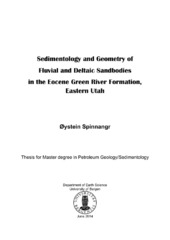| dc.description.abstract | A large part of the world’s remaining hydrocarbon reserves are located in reservoirs of fluvial origin. The main building blocks of these reservoirs are channel‐belt sandbodies with varied geometries and spatial stacking. In the subsurface, their thicknesses can be measured from well logs and/or cores, but their widths remain unknown. The aim of this study is to analyse the fluvial and mouth‐bar sandbody thicknesses and widths in the Sunnyside Delta stratigraphic interval of the Eocene Green River Formation in the eastern Utah to find out if there is a relationship between these parameters, which might then possibly be used for subsurface hydrocarbon reservoir predictions. Conventional sedimentological logging allowed distinction of a wide range of sedimentary facies representing various modes of sediment deposition and 12 subassociations of spatially and genetically related facies representing specific morphodynamic elements of the Green River Formation, including previously unrecognized channel bank‐collapse deposits. They jointly form five main facies associations representing particular depositional palaeoenvironments, such as an open‐water lacustrine system, a lacustrine shoreface system, a deltaic mouth‐bar system, a fluvial channel‐belt system and an alluvial delta‐plain system. On the basis of the facies associations and their spatial organization, the studied stratigraphic interval is interpreted to have recorded the depositional history of an arid to semi‐arid deltaic system building out into a large shallow‐water lake. The low‐gradient delta topography and large lake‐level fluctuations resulted in frequent episodes of extensive flooding of the delta, during which lacustrine carbonate grainstones were deposited as marker stratigraphic horizons. The sandbodies in the interval have a mean width of ~390 m, a mean thickness of ~9 m, and a mean width/thickness ratio of ~39. The width variance and thereby also the width/thickness ratio variance are both high. This is attributed to three main causes: the variable maturity level of channel‐sinuosity development at the stage of channel avulsion; the variable rate of channel aggradation; and a mixture of channel‐belt sandbodies formed by vertical, lateral or combined accretion. The role of this last factor was investigated further by dividing the bulk dataset according to the sandbody type: multi‐storey multilateral channel‐belts, multi‐storey unilateral channel‐belts, single‐storey multilateral channel‐belts, single‐storey unilateral channel‐belts and mouth‐bar sandbodies. This grouping significantly reduced the variance in both width and thickness of sandbodies. The mean palaeo‐channel bankfull width estimated from abandonment plugs is ~61 m and the mean bankfull palaeo‐channel depth estimated from single‐storey channel belts is ~6.8 m. The fluvial system was distributive, and an analysis of the stratigraphic variation in channelbelt cross‐sectional dimensions reveals two progradational phases separated a retrogradational phase. Based on this interpretation, two higher‐order sequences are inferred, which supports the suggestion of Moore et al. (2012) that the sequences of Keighley et al. (2003) should rather be reconsidered as parasequences. The U8 interval of Keighley et al. (2003), originally attributed to a lowstand systems tract is reinterpreted as a transgressive systems tract. In the present interpretation there is a distinct trend towards narrower and thinner channel‐belts in transgressive systems tracts and wider and thicker channel‐belts in lowstand systems tracts. Analyses of the sandbody dimensions along depositional strike have also allowed the lateral location of possible fluvial distributive systems depaxes to be recognized. | en_US |
